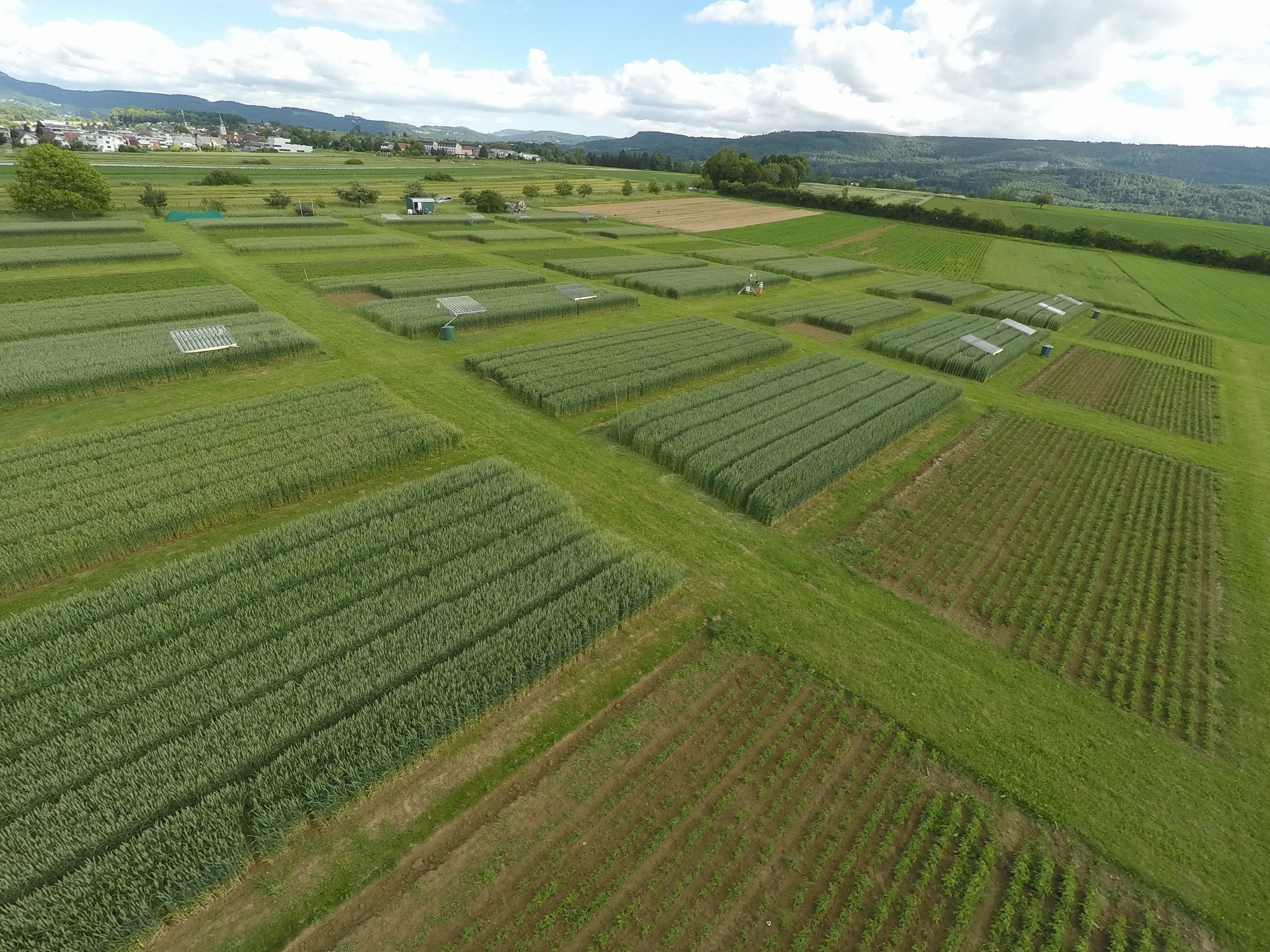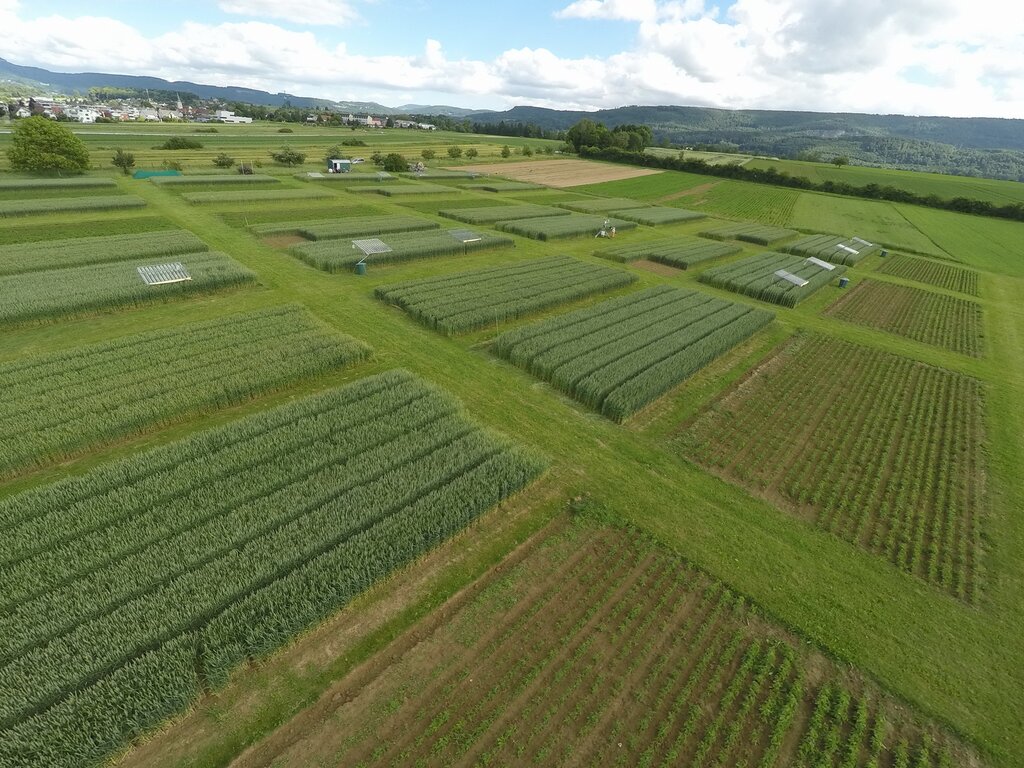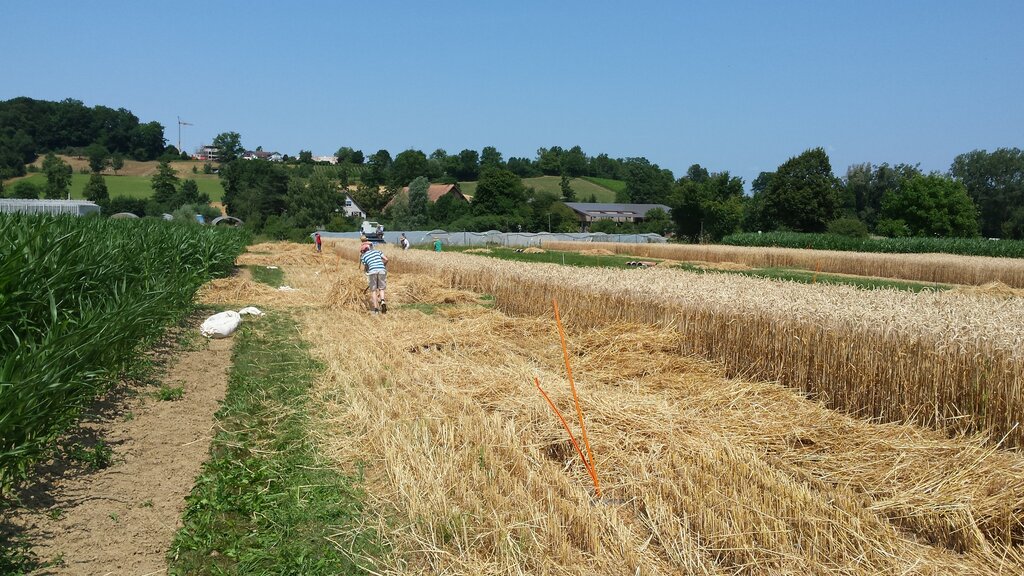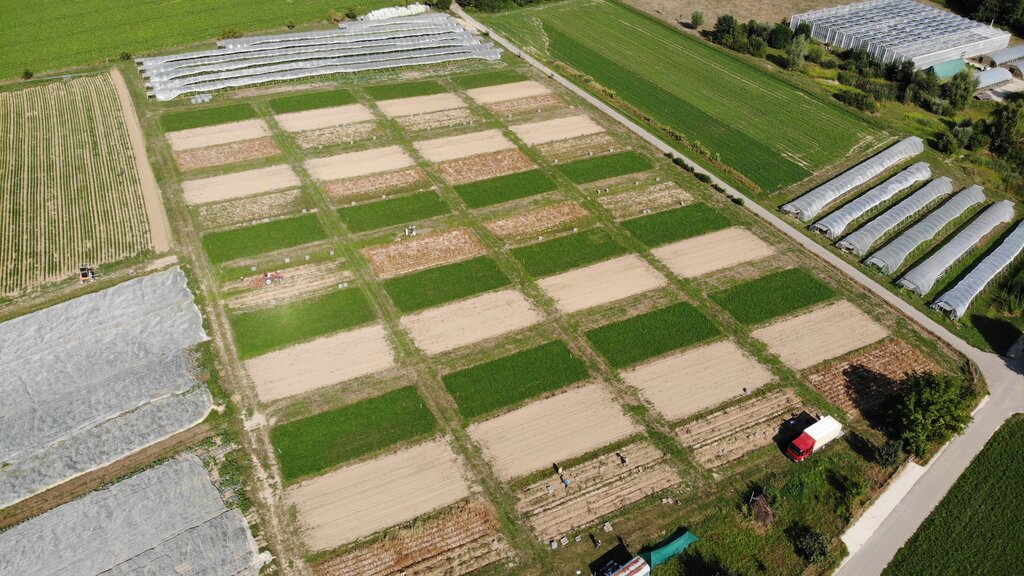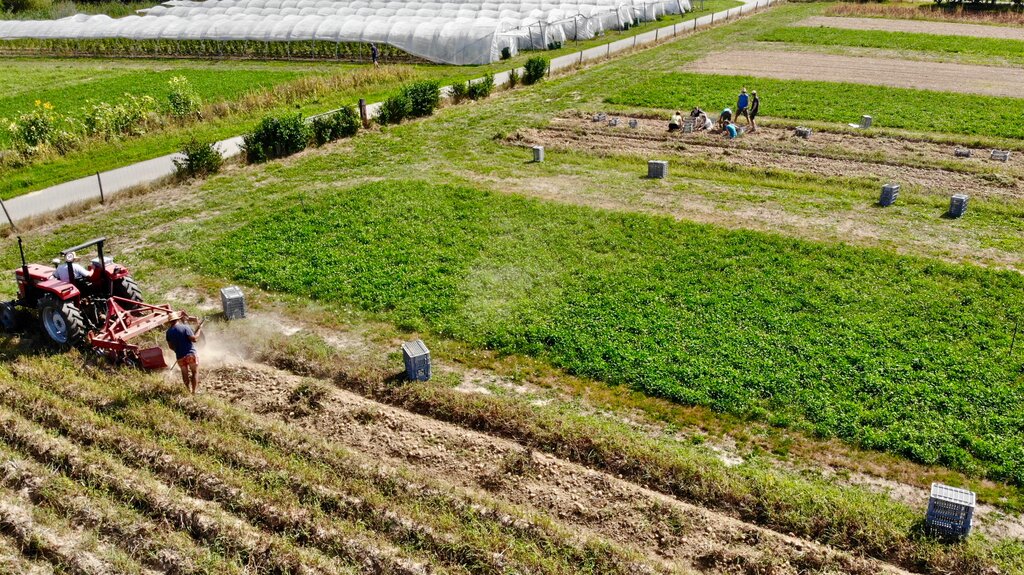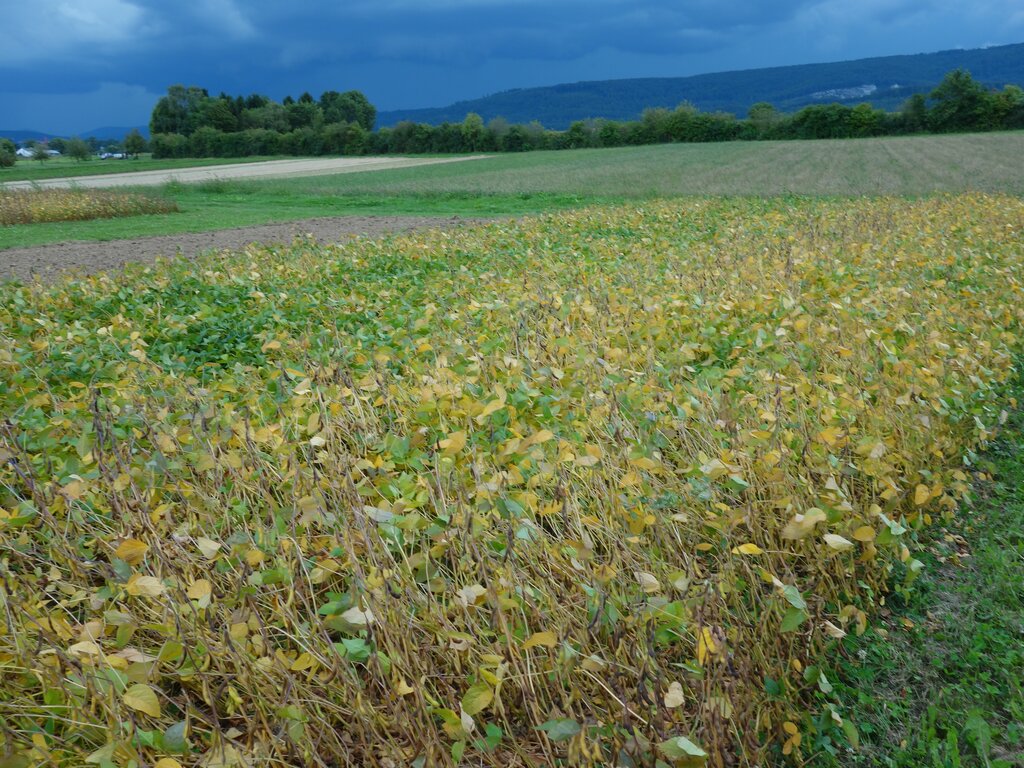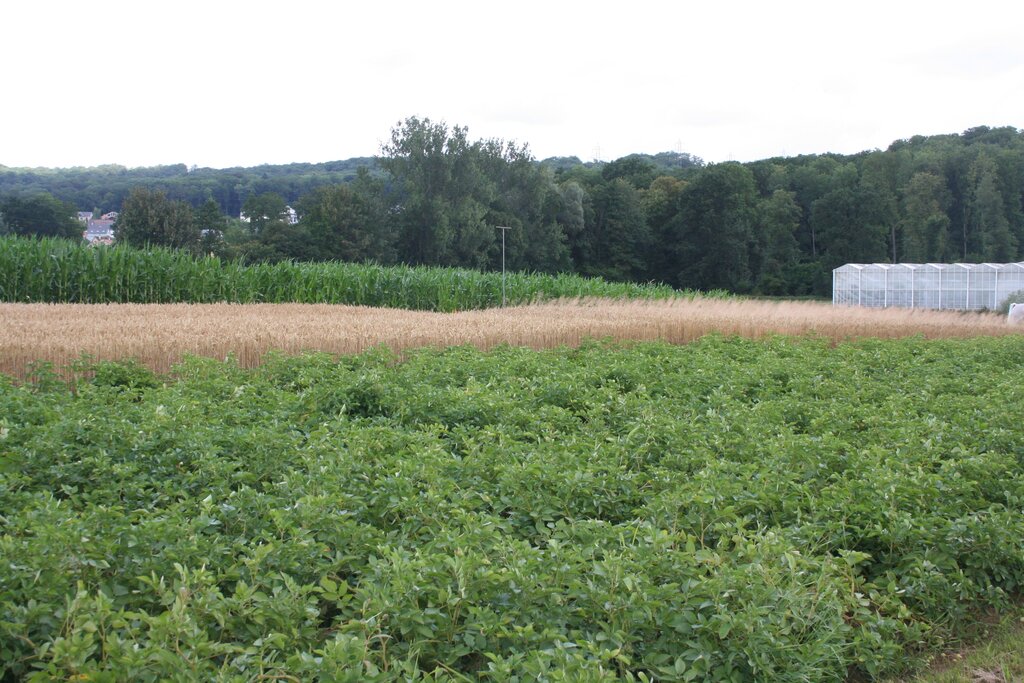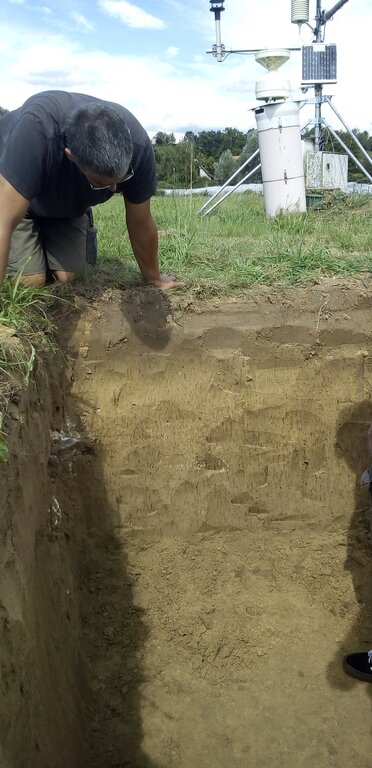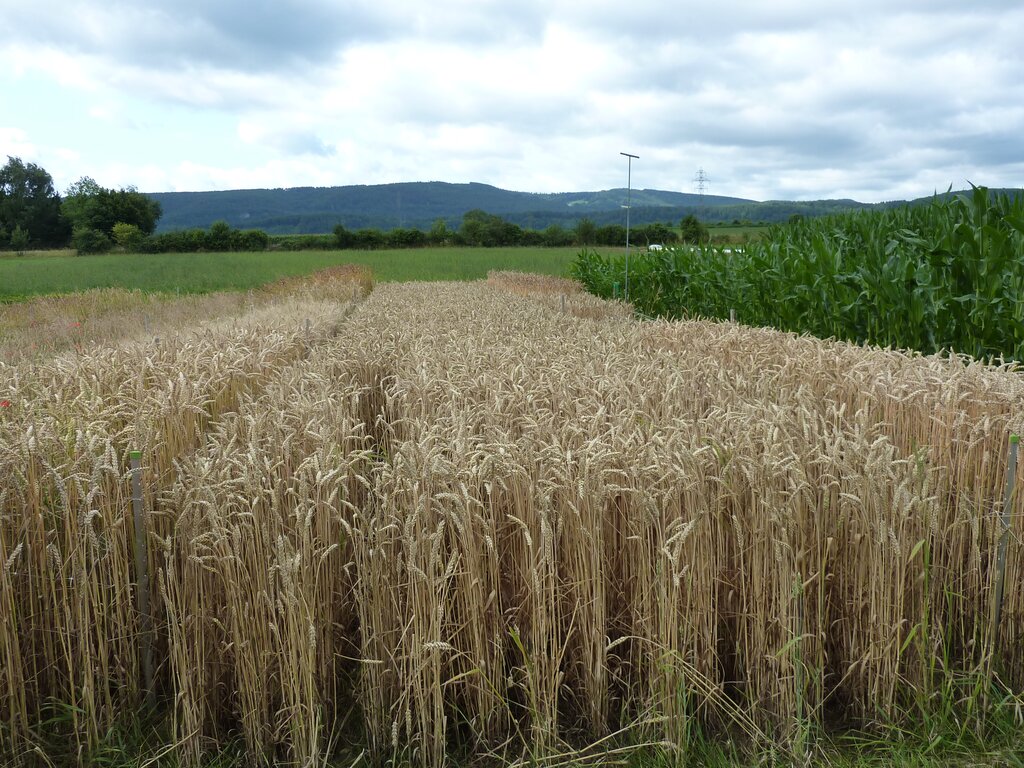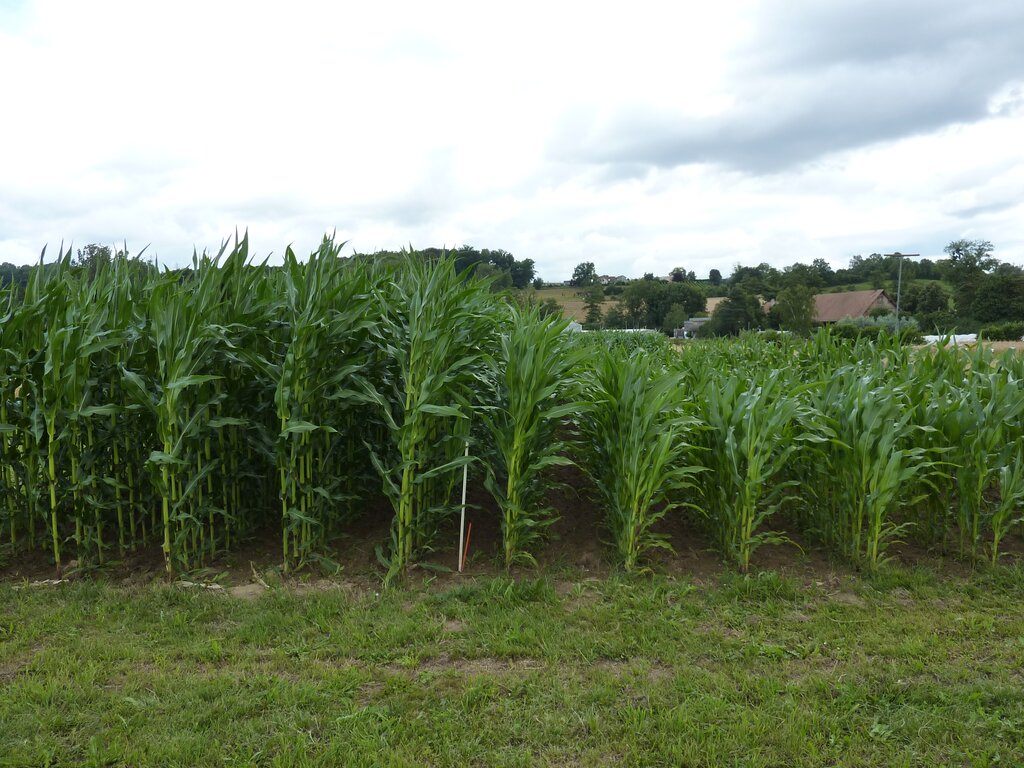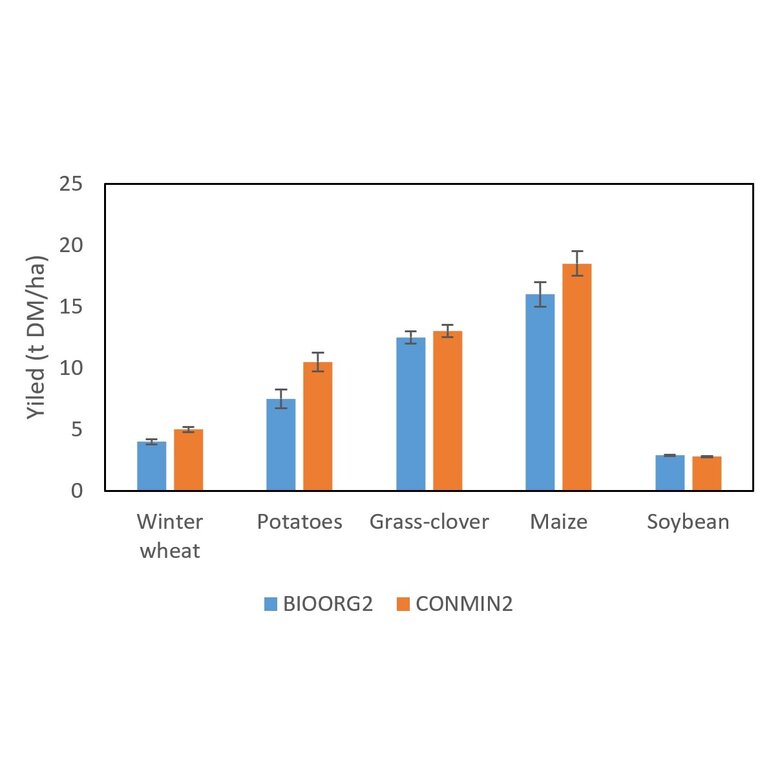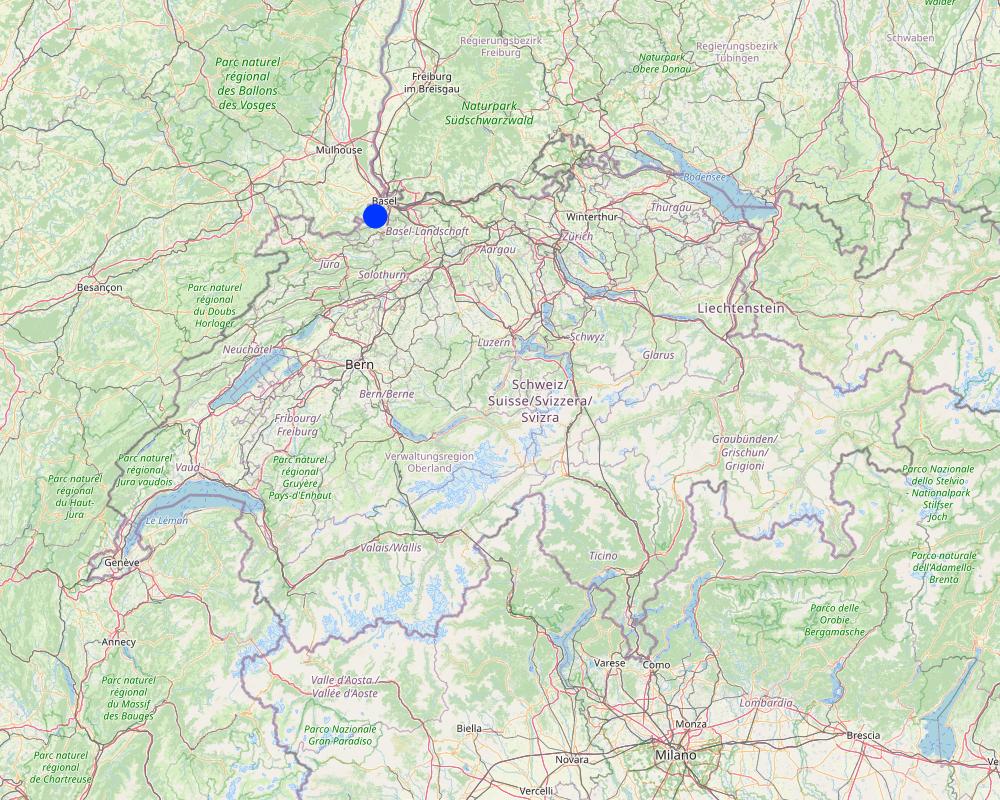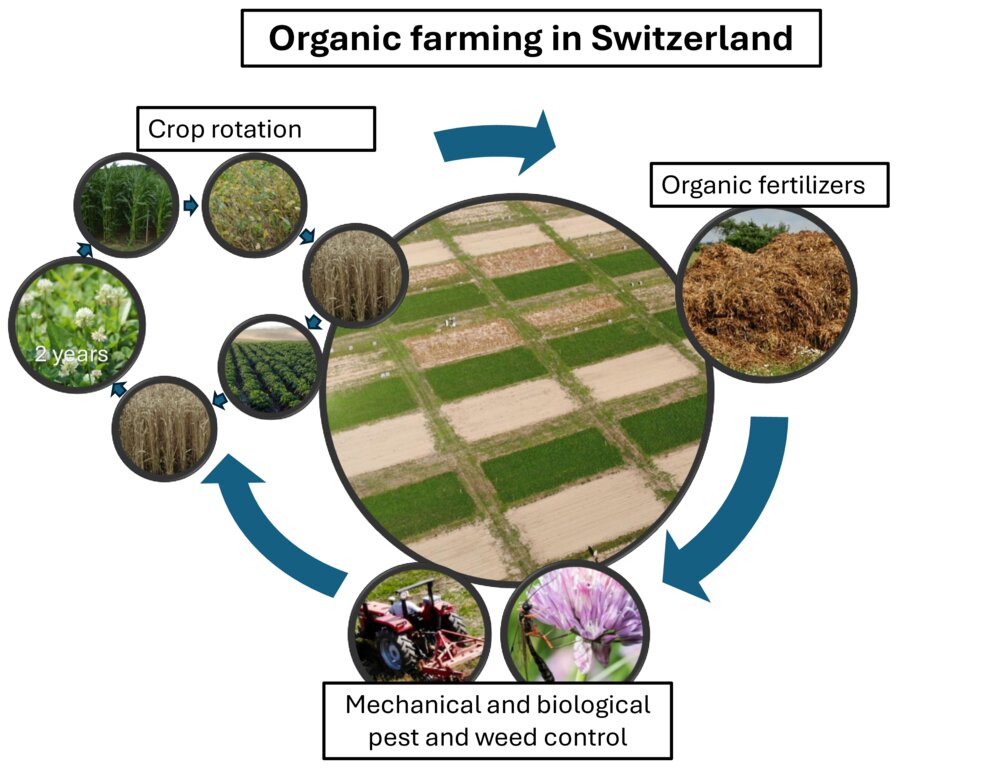Organic Agriculture (DOK Experiment) [สวิตเซอร์แลนด์]
- ผู้สร้างสรรค์:
- การอัพเดท:
- ผู้รวบรวม: Moritz Laub
- ผู้เรียบเรียง: Jochen Mayer, Hans-Martin Krause
- ผู้ตรวจสอบ: Rima Mekdaschi Studer, William Critchley
Biologischer Landbau/ Biologische Landwirtschaft
technologies_7138 - สวิตเซอร์แลนด์
ดูส่วนย่อย
ขยายทั้งหมด ย่อทั้งหมด1. ข้อมูลทั่วไป
1.2 รายละเอียดที่ติดต่อได้ของผู้รวบรวมและองค์กรที่เกี่ยวข้องในการประเมินและการจัดเตรียมทำเอกสารของเทคโนโลยี
ผู้เชี่ยวชาญ SLM:
ชื่อของโครงการซึ่งอำนวยความสะดวกในการทำเอกสารหรือการประเมินเทคโนโลยี (ถ้าเกี่ยวข้อง)
Land Use Based Mitigation for Resilient Climate Pathways (LANDMARC)ชื่อขององค์กรซึ่งอำนวยความสะดวกในการทำเอกสารหรือการประเมินเทคโนโลยี (ถ้าเกี่ยวข้อง)
Research institut for organic agriculture (FiBL) - สวิตเซอร์แลนด์ชื่อขององค์กรซึ่งอำนวยความสะดวกในการทำเอกสารหรือการประเมินเทคโนโลยี (ถ้าเกี่ยวข้อง)
Forschungsanstalt Agroscope Reckenholz-Tänikon ART (Forschungsanstalt Agroscope Reckenholz-Tänikon ART) - สวิตเซอร์แลนด์ชื่อขององค์กรซึ่งอำนวยความสะดวกในการทำเอกสารหรือการประเมินเทคโนโลยี (ถ้าเกี่ยวข้อง)
ETH-Zürich (ETH-Zürich) - สวิตเซอร์แลนด์1.3 เงื่อนไขการใช้ข้อมูลที่ได้บันทึกผ่านทาง WOCAT
ผู้รวบรวมและวิทยากรหลักยอมรับเงื่อนไขเกี่ยวกับการใช้ข้อมูลที่ถูกบันทึกผ่านทาง WOCAT:
ใช่
1.4 การเปิดเผยเรื่องความยั่งยืนของเทคโนโลยีที่ได้อธิบายไว้
เทคโนโลยีที่ได้อธิบายไว้นี้เป็นปัญหาของความเสื่อมโทรมโทรมของที่ดินหรือไม่ จึงไม่ได้รับการยอมรับว่าเป็นเทคโนโลยีเพื่อการจัดการที่ดินอย่างยั่งยืน:
ไม่ใช่
2. การอธิบายลักษณะของเทคโนโลยี SLM
2.1 การอธิบายแบบสั้น ๆ ของเทคโนโลยี
คำจำกัดความของเทคโนโลยี:
Organic agriculture is a system of crop cultivation that uses biological methods of pest control and organic fertilizer as substitutes for chemical fertilizers and pesticides. It targets sustainability, enhancement of soil fertility, and biological diversity by aiming to close nutrient cycles while generally prohibiting synthetic pesticides, antibiotics, synthetic fertilizers, genetically modified organisms, and growth hormones.
2.2 การอธิบายแบบละเอียดของเทคโนโลยี
คำอธิบาย:
Organic agriculture is a globally applied technology practiced on agricultural land. It is carried out in 188 countries, with over 96 million hectares of agricultural land managed organically by at least 4.5 million farmers.
The main elements of this technology include the use of biological methods of pest control and organic fertilizer application, which replace chemical fertilizers and pesticides. It generally prohibits synthetic pesticides, antibiotics, synthetic fertilizers, genetically modified organisms, and growth hormones. The purpose of organic agriculture is to achieve sustainability in farming, enhancing soil fertility, increasing biological diversity and reducing the reliance on external inputs to agriculture, relying on nutrient recycling by applying manure and on biological nitrogen fixation from legumes. It also aims to provide a healthier and more environmentally friendly alternative to conventional farming practices. To establish and maintain organic agriculture, major activities include the application of organic fertilizers, crop rotation, and the use of pest-resistant plant varieties. Regular soil testing and monitoring of pest populations are also necessary. Certification of a farm as being officially organic is needed if the products are to be sold at a price premium.
Organic agriculture can improve soil health, reduce pollution of the surrounding environment, and contribute to biodiversity in the fields. Moreover, it can offer healthier food options and potentially higher income for farmers due to the premium prices of organic products. Land users appreciate organic agriculture for its environmental benefits and potential for higher income. However, some dislike the increased labour and time required, the 10-30% of reduction in yields, compared to conventional agriculture, as well as the need for a transition period before farms can be certified as organic and products sold at a premium price.
The DOK experiment presented here is representative of organic practices in the context of temperate regions (specifically, Switzerland and surrounding countries). It is jointly managed by the Research Institute of Organic Agriculture (FiBL), and by the Swiss Confederation's centre of excellence for agricultural research (Agroscope). The name "DOK Experiment" is derived from its main purpose, to compare three cultivation systems: Biodynamic (D), organic (O) and conventional (K) agriculture. These differ in terms of how they are fertilized (D: liquid manure, manure compost, biodynamic preparations; O: liquid manure, rotted manure; K: two variants, one with liquid manure, fresh or rotted manure, mineral fertilizer (CONFYM variant) and one with only mineral fertilizer (CONMIN variant)), as well as by plant protection (D and O: organic; K: chemical-synthetic). In addition to two fertilization levels of the three cultivation systems (half fertilization and standard practice fertilization), two controls are carried out, an unfertilized (N) and a purely mineral-fertilized variant (M). The experiment is spatially replicated four times. The results presented here refer to the conventional (K) and the organic (O) treatments at the standard practice fertilization level.
2.3 รูปภาพของเทคโนโลยี
2.4 วีดีโอของเทคโนโลยี
ความคิดเห็น/อธิบายสั้นๆ:
DOK-Versuch: Biologische und konventionelle Landwirtschaft im Langzeitvergleich
https://www.youtube.com/watch?v=gDCLHxU0ijg
วันที่:
16/07/2014
สถานที่:
Therwil
ความคิดเห็น/อธิบายสั้นๆ:
Der DOK-Versuch - Eine Internationale Forschungsplattform (Juni 2015)
https://www.youtube.com/watch?v=QYBS4Qj7T14
วันที่:
16/06/2015
สถานที่:
Therwil
2.5 ประเทศภูมิภาค หรือสถานที่ตั้งที่เทคโนโลยีได้นำไปใช้และได้รับการครอบคลุมโดยการประเมินนี้
ประเทศ:
สวิตเซอร์แลนด์
ภูมิภาค/รัฐ/จังหวัด:
Basel
ข้อมูลจำเพาะเพิ่มเติมของสถานที่ตั้ง :
Therwil
ระบุการกระจายตัวของเทคโนโลยี:
- ใช้ ณ จุดที่เฉพาะเจาะจงหรือเน้นไปยังบริเวณพื้นที่ขนาดเล็ก
Is/are the technology site(s) located in a permanently protected area?
ไม่ใช่
Map
×2.6 วันที่การดำเนินการ
ระบุปีที่ใช้:
1978
2.7 คำแนะนำของเทคโนโลยี
ให้ระบุว่าเทคโนโลยีถูกแนะนำเข้ามาอย่างไร:
- ในช่วงการทดลองหรือการทำวิจัย
ความคิดเห็น (ประเภทของโครงการ เป็นต้น) :
This is a research site, investigating the benefits of organic agriculture.
3. การจัดประเภทของเทคโนโลยี SLM
3.1 วัตถุประสงค์หลักของเทคโนโลยี
- ลด ป้องกัน ฟื้นฟู การเสื่อมโทรมของที่ดิน
- อนุรักษ์ระบบนิเวศน์
- รักษาสภาพหรือปรับปรุงความหลากหลายทางชีวภาพ
- สร้างผลกระทบทางด้านสังคมที่เป็นประโยชน์
3.2 ประเภทของการใช้ที่ดินในปัจจุบันที่ได้นำเทคโนโลยีไปใช้
Land use mixed within the same land unit:
ไม่ใช่

พื้นที่ปลูกพืช
- การปลูกพืชล้มลุกอายุปีเดียว
Annual cropping - Specify crops:
- cereals - maize
- cereals - wheat (winter)
- fodder crops - clover
- legumes and pulses - soya
- root/tuber crops - potatoes
Annual cropping system:
Wheat or similar rotation with hay/pasture
จำนวนของฤดูเพาะปลูกต่อปี:
- 1
Is crop rotation practiced?
ใช่
ถ้าใช่ ระบุ:
The typical crop rotation over the last three cycles was: silage maize, soybean, winter wheat, potato, winter wheat, and two years of grass-clover (Knapp et al. 2023).
3.3 Has land use changed due to the implementation of the Technology?
Has land use changed due to the implementation of the Technology?
- No (Continue with question 3.4)
3.4 การใช้น้ำ
การใช้น้ำของที่ดินที่มีการใช้เทคโนโลยีอยู่:
- จากน้ำฝน
3.5 กลุ่ม SLM ที่ตรงกับเทคโนโลยีนี้
- ระบบหมุนเวียน (การปลูกพืชหมุนเวียน การพักดิน การเกษตรแบบไร่เลื่อนลอย)
- การจัดการปลูกพืชร่วมกับปศุสัตว์
- การจัดการศัตรูพืชและโรคพืชแบบผสมผสาน (รวมถึงเกษตรอินทรีย์ด้วย)
3.6 มาตรการ SLM ที่ประกอบกันเป็นเทคโนโลยี

มาตรการจัดการพืช
- A2: อินทรียวัตถุในดิน/ความอุดมสมบูรณ์ในดิน
- A5: การจัดการเมล็ดพันธุ์ การปรับปรุงพันธุ์
- A6: Residue management
A6: Specify residue management:
A 6.4: retained
แสดงความคิดเห็น:
Comment to A5: It is aimed to use pest-resistant crop varieties, because chemical pesticides are not allowed in organic agriculture.
3.7 รูปแบบหลักของการเสื่อมโทรมของที่ดินที่ได้รับการแก้ไขโดยเทคโนโลยี

การเสื่อมโทรมของดินทางด้านเคมี
- Cn (Fertility decline): ความอุดมสมบูรณ์และปริมาณอินทรียวัตถุในดินถูกทำให้ลดลงไป (ไม่ได้เกิดจากสาเหตุการกัดกร่อน)

การเสื่อมโทรมของดินทางด้านชีวภาพ
- Bs (Quality and species composition): องค์ประกอบหรือความหลากหลายทางคุณภาพและชนิดพันธุ์ลดลง
- Bl (Loss of soil life): การสูญเสียสิ่งมีชีวิตในดิน
3.8 การป้องกัน การลดลง หรือการฟื้นฟูความเสื่อมโทรมของที่ดิน
ระบุเป้าหมายของเทคโนโลยีกับความเสื่อมโทรมของที่ดิน:
- ป้องกันความเสื่อมโทรมของที่ดิน
- ลดความเสื่อมโทรมของดิน
4. ข้อมูลจำเพาะด้านเทคนิค กิจกรรมการนำไปปฏิบัติใช้ ปัจจัยนำเข้า และค่าใช้จ่าย
4.1 แบบแปลนทางเทคนิคของเทคโนโลยี
ข้อมูลจำเพาะด้านเทคนิค (แบบแปลนทางเทคนิคของเทคโนโลยี):
A summary of the principles of organic farming in Switzerland
ผู้เขียน:
Moritz Laub
วันที่:
26/06/2024
4.2 ข้อมูลทั่วไปเกี่ยวกับการคำนวณปัจจัยนำเข้าและค่าใช้จ่าย
ให้ระบุว่าค่าใช้จ่ายและปัจจัยนำเข้าได้รับการคำนวณอย่างไร:
- ต่อพื้นที่ที่ใช้เทคโนโลยี
ระบุขนาดและหน่วยพื้นที่:
ha
If using a local area unit, indicate conversion factor to one hectare (e.g. 1 ha = 2.47 acres): 1 ha =:
1 ha
อื่นๆ หรือสกุลเงินประจำชาติ (ระบุ):
CHF
If relevant, indicate exchange rate from USD to local currency (e.g. 1 USD = 79.9 Brazilian Real): 1 USD =:
0.91
ระบุค่าเฉลี่ยของค่าจ้างในการจ้างแรงงานต่อวัน:
160-240
4.3 กิจกรรมเพื่อการจัดตั้ง
| กิจกรรม | Timing (season) | |
|---|---|---|
| 1. | Courses on the principles of organic farming | Before transition |
| 2. | Transitioning period (already practicing but not yet certified) | 2 years |
| 3. | Certification | Start of year 3 |
แสดงความคิดเห็น:
Detailed information on the transition process and requirements can be found here:
https://www.fibl.org/de/shop/1001-umstellung
4.4 ค่าใช้จ่ายของปัจจัยนำเข้าที่จำเป็นสำหรับการจัดตั้ง
แสดงความคิดเห็น:
Courses are needed when transitioning to organic agriculture. They usually take around a week and the cost of courses depends locally.
Further, there are costs for certification, which are usually 400 CHF.
The main costs of transitioning is lost yields in the years during transition, when there is no price premium, yet. Subsidies depend on the Swiss Canton.
Some detailed information on the cost associated with transition can be found here:
https://www.bioaktuell.ch/grundlagen/umstellung/allgemein/kosten-und-beitraege
4.5 การบำรุงรักษาสภาพหรือกิจกรรมที่เกิดขึ้นเป็นประจำ
| กิจกรรม | ช่วงระยะเวลา/ความถี่ | |
|---|---|---|
| 1. | Application of manure | At least yearly |
| 2. | Application of slurry | Usually twice a year |
| 3. | Soil preparation by harrow or cultivator | Yearly |
| 4. | Weed supression by tine weeder | At least yearly |
| 5. | Biological pesticide application (e.g., Novodor) | When needed, mostly in potato |
| 6. | Planting of cover crop | After wheat |
| 7. | Mulching cover crop | Before planting soy/maize |
แสดงความคิดเห็น:
The measures here reflect the activities that are in addition to conventional management needs. Their exact sequence depends on selected crop rotation. In the DOK experiment is was silage maize, soybean, winter wheat, potato, winter wheat, and two years of grass-clover.
4.6 ค่าใช้จ่ายของปัจจัยนำเข้าและกิจกรรมที่เกิดขึ้นเป็นประจำที่ต้องการการบำรุงรักษา (ต่อปี)
| ปัจจัยนำเข้า | หน่วย | ปริมาณ | ค่าใช้จ่ายต่อหน่วย | ค่าใช้จ่ายทั้งหมดต่อปัจจัยนำเข้า | %ของค่าใช้จ่ายที่ก่อให้เกิดขึ้นโดยผู้ใช้ที่ดิน | |
|---|---|---|---|---|---|---|
| แรงงาน | Labour requirements compared to conventional agriculture | % | 113.0 |
แสดงความคิดเห็น:
Because this is a research trial, the detailed costs are neither available nor would they be representative of typical organic farms. Therefore, it is best to rely on the estimated costs from an international study. Based on this study there are 13% higher labour costs in organic farming, but the higher labor cost in organic systems is offset by lower costs of purchased inputs. The total production cost is not different to conventional farming. When the actual organic premiums are considered, gross returns, benefit/cost ratios, and net present values are significantly higher for organic crops compared to conventional crops (21%, 24%, and 35%, respectively).
The study is available here:
https://www.doi.org/10.1073/pnas.1423674112
A good way to estimate the costs of organic vs conventional production is the KTBL Performance Cost calulator. It can be specified to farm and machinery size, soil type and has an option for organic agriculture to see the differences. (only in German language):
https://daten.ktbl.de/dslkrpflanze/postHv.html
4.7 ปัจจัยสำคัญที่สุดที่มีผลกระทบต่อค่าใช้จ่าย
ปัจจัยสำคัญที่สุดที่มีผลกระทบต่อค่าใช้จ่ายต่างๆ:
Reduced yield without price premium during transition period.
5. สิ่งแวดล้อมทางธรรมชาติและของมนุษย์
5.1 ภูมิอากาศ
ฝนประจำปี
- < 250 ม.ม.
- 251-500 ม.ม.
- 501-750 ม.ม.
- 751-1,000 ม.ม.
- 1,001-1,500 ม.ม.
- 1,501-2,000 ม.ม.
- 2,001-3,000 ม.ม.
- 3,001-4,000 ม.ม.
- > 4,000 ม.ม.
ระบุปริมาณน้ำฝนเฉลี่ยรายปี (ถ้ารู้) :หน่วย ม.ม.
840.00
ข้อมูลจำเพาะ/ความคิดเห็นเรื่องปริมาณน้ำฝน:
Typical temperate climate. Rainfall is mostly evenly distributed throughout the year with slightly higher values in May, June, July and August.
เขตภูมิอากาศเกษตร
- ชื้น
5.2 สภาพภูมิประเทศ
ค่าเฉลี่ยความลาดชัน:
- ราบเรียบ (0-2%)
- ลาดที่ไม่ชัน (3-5%)
- ปานกลาง (6-10%)
- เป็นลูกคลื่น (11-15%)
- เป็นเนิน (16-30%)
- ชัน (31-60%)
- ชันมาก (>60%)
ธรณีสัณฐาน:
- ที่ราบสูง/ที่ราบ
- สันเขา
- ไหล่เขา
- ไหล่เนินเขา
- ตีนเนิน
- หุบเขา
ระดับความสูง:
- 0-100 เมตร
- 101-500 เมตร
- 501-1,000 เมตร
- 1,001-1,500 เมตร
- 1,501-2,000 เมตร
- 2,001-2,500 เมตร
- 2,501-3,000 เมตร
- 3,001-4,000 เมตร
- > 4,000 เมตร
ให้ระบุถ้าเทคโนโลยีได้ถูกนำไปใช้:
- ไม่เกี่ยวข้อง
5.3 ดิน
ค่าเฉลี่ยความลึกของดิน:
- ตื้นมาก (0-20 ซ.ม.)
- ตื้น (21-50 ซ.ม.)
- ลึกปานกลาง (51-80 ซ.ม.)
- ลึก (81-120 ซ.ม.)
- ลึกมาก (>120 ซ.ม.)
เนื้อดิน (ดินชั้นบน):
- ปานกลาง (ดินร่วน ทรายแป้ง)
เนื้อดินล่าง (> 20 ซ.ม.ต่ำจากผิวดิน):
- ปานกลาง (ดินร่วน ทรายแป้ง)
อินทรียวัตถุในดิน:
- ปานกลาง (1-3%)
5.4 ความเป็นประโยชน์และคุณภาพของน้ำ
ระดับน้ำใต้ดิน:
5-50 เมตร
น้ำไหลบ่าที่ผิวดิน:
ดี
คุณภาพน้ำ (ที่ยังไม่ได้บำบัด):
เป็นน้ำเพื่อการดื่มที่ดี
Water quality refers to:
ground water
ความเค็มของน้ำเป็นปัญหาหรือไม่:
ไม่ใช่
กำลังเกิดน้ำท่วมในพื้นที่หรือไม่:
ไม่ใช่
5.5 ความหลากหลายทางชีวภาพ
ความหลากหลายทางชนิดพันธุ์:
- ปานกลาง
ความหลากหลายของแหล่งที่อยู่:
- ปานกลาง
5.6 ลักษณะของผู้ใช้ที่ดินที่นำเทคโนโลยีไปปฏิบัติใช้
อยู่กับที่หรือเร่ร่อน:
- อยู่กับที่
แนวทางการตลาดของระบบการผลิต:
- ทำการค้า/การตลาด
รายได้ที่มาจากนอกฟาร์ม:
- 10-50% ของรายได้ทั้งหมด
ระดับของความมั่งคั่งโดยเปรียบเทียบ:
- พอมีพอกิน
เป็นรายบุคคล/ครัวเรือน:
- เป็นรายบุคคล/ครัวเรือน
ระดับของการใช้เครื่องจักรกล:
- การใช้เครื่องจักรหรือเครื่องยนต์
เพศ:
- หญิง
- ชาย
อายุของผู้ใช้ที่ดิน:
- วัยกลางคน
5.7 Average area of land used by land users applying the Technology
- < 0.5 เฮกตาร์
- 0.5-1 เฮกตาร์
- 1-2 เฮกตาร์
- 2-5 เฮกตาร์
- 5-15 เฮกตาร์
- 15-50 เฮกตาร์
- 50-100 เฮกตาร์
- 100-500 เฮกตาร์
- 500-1,000 เฮกตาร์
- 1,000-10,000 เฮกตาร์
- >10,000 เฮกตาร์
พิจารณาว่าเป็นขนาดเล็ก กลาง หรือขนาดใหญ่ (ซึ่งอ้างอิงถึงบริบทระดับท้องถิ่น):
- ขนาดกลาง
แสดงความคิดเห็น:
Area refers to typical users (not the DOK Experiment)
5.8 กรรมสิทธิ์ในที่ดิน สิทธิในการใช้ที่ดินและสิทธิในการใช้น้ำ
กรรมสิทธิ์ในที่ดิน:
- รายบุคคล ได้รับสิทธิครอบครอง
สิทธิในการใช้ที่ดิน:
- เช่า
- รายบุคคล
- irrigation not common
Are land use rights based on a traditional legal system?
ไม่ใช่
5.9 การเข้าถึงบริการและโครงสร้างพื้นฐาน
สุขภาพ:
- จน
- ปานกลาง
- ดี
การศึกษา:
- จน
- ปานกลาง
- ดี
ความช่วยเหลือทางด้านเทคนิค:
- จน
- ปานกลาง
- ดี
การจ้างงาน (เช่น ภายนอกฟาร์ม):
- จน
- ปานกลาง
- ดี
ตลาด:
- จน
- ปานกลาง
- ดี
พลังงาน:
- จน
- ปานกลาง
- ดี
ถนนและการขนส่ง:
- จน
- ปานกลาง
- ดี
น้ำดื่มและการสุขาภิบาล:
- จน
- ปานกลาง
- ดี
บริการด้านการเงิน:
- จน
- ปานกลาง
- ดี
6. ผลกระทบและสรุปคำบอกกล่าว
6.1 ผลกระทบในพื้นที่ดำเนินการ (On-site) จากการใช้เทคโนโลยี
ผลกระทบทางด้านเศรษฐกิจและสังคม
การผลิต
การผลิตพืชผล
จำนวนก่อน SLM:
Mean wheat yield of 5 t DM/ha
หลังจาก SLM:
Mean wheat yield of 4 t DM/ha
แสดงความคิดเห็น/ระบุ:
Other mean yields of organic treatment (BIOORG2 with 1.4 livestock units):
Potatoes: 7.5 t DM/ha
Soybean: 2.8 t DM/ha
Other mean yields of conventional treatment with only mineral fertilizer(CONMIN2):
Potatoes: 10 t DM/ha
Soybean: 2.8 t DM/ha
การผลิตพืชที่ใช้เลี้ยงปศุสัตว์
จำนวนก่อน SLM:
Grass-clover: 13 t DM/ha
หลังจาก SLM:
Grass-clover: 12.5 t DM/ha
แสดงความคิดเห็น/ระบุ:
Other mean yields of organic treatment (BIOORG2 with 1.4 livestock units):
Maize silage: 17 t DM/ha
Other mean yields of conventional treatment with only mineral fertilizer(CONMIN2):
Maize silage: 19 t DM/ha
รายได้และค่าใช้จ่าย
ค่าใช่จ่ายของปัจจัยการผลิตทางการเกษตร
แสดงความคิดเห็น/ระบุ:
Refers to overall organic agriculture in Switzerland (not DOK experiment)
รายได้จากฟาร์ม
แสดงความคิดเห็น/ระบุ:
Refers to overall organic agriculture in Switzerland (not DOK experiment)
ความหลากหลายของแหล่งผลิตรายได้
แสดงความคิดเห็น/ระบุ:
Refers to overall organic agriculture in Switzerland (not DOK experiment)
ภาระงาน
แสดงความคิดเห็น/ระบุ:
Refers to overall organic agriculture in Switzerland (not DOK experiment)
ผลกระทบด้านนิเวศวิทยา
ดิน
อินทรียวัตถุในดิน/ต่ำกว่าดินชั้น C
จำนวนก่อน SLM:
About 1.3% SOC in the mineral fertilizer treatment in 2020
หลังจาก SLM:
About 1.6% SOC in the organic agriculture treatment in 2020
แสดงความคิดเห็น/ระบุ:
Organic treatment refers to BIOORG2 with 1.4 livestock units. Conventional treatment to the one with only mineral fertilizer (CONMIN2).
ความเป็นกรด
จำนวนก่อน SLM:
pH of 6.3 in the mineral fertilizer treatment in 2020
หลังจาก SLM:
pH of 6.5 in the organic agriculture treatment in 2020
แสดงความคิดเห็น/ระบุ:
Organic treatment refers to BIOORG2 with 1.4 livestock units. Conventional treatment to the one with only mineral fertilizer (CONMIN2).
Specify assessment of on-site impacts (measurements):
All presented results are from published studies about the DOK experiment.
6.2 ผลกระทบนอกพื้นที่ดำเนินการ (Off-site) จากการใช้เทคโนโลยี
การเกิดมลพิษในน้ำบาดาลหรือแม่น้ำ
Greenhouse gas emissions per land area
แสดงความคิดเห็น/ระบุ:
Based on a recent modeling study, emissions were between 0.5 to 1 t CO2 equivalent less per ha and year in organic compared to conventional agriculture in Switzerland (https://doi.org/10.1016/j.agsy.2020.102822).
Greenhouse gas emissions per calorie
แสดงความคิดเห็น/ระบุ:
In contrast to emissions per land area, it has been found that due to the lower yields there is little difference in terms of emissions per unit of food produced (https://doi.org/10.1088/1748-9326/aa6cd5).
Specify assessment of off-site impacts (measurements):
There are ongoing debates on whether organic agriculture really leads to lower emissions than conventional agriculture, and the conclusion largely depends on the unit of reference (amount of food vs. per ha).
6.3 การเผชิญและความตอบสนองของเทคโนโลยีต่อการเปลี่ยนแปลงสภาพภูมิอากาศที่ค่อยเป็นค่อยไป และสภาพรุนแรงของภูมิอากาศ / ภัยพิบัติ (ที่รับรู้ได้โดยผู้ใช้ที่ดิน)
การเปลี่ยนแปลงสภาพภูมิอากาศที่ค่อยเป็นค่อยไป
การเปลี่ยนแปลงสภาพภูมิอากาศที่ค่อยเป็นค่อยไป
| ฤดู | increase or decrease | เทคโนโลยีมีวิธีการรับมืออย่างไร | |
|---|---|---|---|
| อุณหภูมิประจำปี | เพิ่มขึ้น | ดี | |
| ฝนตามฤดู | ฤดูร้อน | ลดลง | ดี |
สภาพรุนแรงของภูมิอากาศ (ภัยพิบัติ)
ภัยพิบัติจากสภาพภูมิอากาศ
| เทคโนโลยีมีวิธีการรับมืออย่างไร | |
|---|---|
| ภัยจากฝนแล้ง | ปานกลาง |
แสดงความคิดเห็น:
Preliminary results from rain-emission shelters indicates similar resilience of the organic agriculture treatment as the conventional ones to drought.
However, organic agriculture in general is expected to better cope with climate change than conventional agriculture (https://www.fibl.org/fileadmin/documents/shop/1500-climate-change.pdf)
6.4 การวิเคราะห์ค่าใช้จ่ายและผลประโยชน์ที่ได้รับ
ผลประโยชน์ที่ได้รับเปรียบเทียบกับค่าใช้จ่ายในการจัดตั้งเป็นอย่างไร (จากมุมมองของผู้ใช้ที่ดิน)
ผลตอบแทนระยะสั้น:
ด้านลบ
ผลตอบแทนระยะยาว:
ด้านบวก
ผลประโยชน์ที่ได้รับเปรียบเทียบกับค่าใช้จ่ายในการบำรุงรักษาหรือต้นทุนที่เกิดขึ้นซ้ำอีก เป็นอย่างไร (จากมุมมองของผู้ใช้ที่ดิน)
ผลตอบแทนระยะสั้น:
ด้านบวกเล็กน้อย
ผลตอบแทนระยะยาว:
ด้านบวกเล็กน้อย
แสดงความคิดเห็น:
The main establishment costs is that in the first years of establishment, farmers have to apply all organic principles and thus have lower yields. However, certification as organic produce, which receive price premiums, is only possible 1-3 years after establishment, depending on the farm type. Thus, there is a period in which the lower yields are not yet compensated by a price premium. Once the system is certified and a price premium received, gross returns, benefit/cost ratios, and net present values are significantly higher for organic crops compared to conventional crops (https://www.doi.org/10.1073/pnas.1423674112)
6.5 การปรับตัวของเทคโนโลยี
- 11-50%
ถ้ามีข้อมูลให้บอกปริมาณด้วย (จำนวนของครัวเรือนหรือครอบคลุมพื้นที่):
About 16% of all farms in Switzerland are currently organic. (BAFU; https://www.bfs.admin.ch/news/de/2024-0392)
Of all those who have adopted the Technology, how many did so spontaneously, i.e. without receiving any material incentives/ payments?
- 51-90%
แสดงความคิดเห็น:
Switzerland has specific subsidies for those that practice organic farming but also many subsidies that all farmers receive. It is thus not 100% clear how many farmers were mainly incentivized by the additional subsidies. However, most become organic farmers out of conviction that it is the better and more sustainable farming system.
6.6 การปรับตัว
เทคโนโลยีได้รับการปรับเปลี่ยนเมื่อเร็วๆนี้ เพื่อให้ปรับตัวเข้ากับสภาพที่กำลังเปลี่ยนแปลงหรือไม่:
ไม่ใช่
6.7 จุดแข็ง / ข้อได้เปรียบ / โอกาสของเทคโนโลยี
| จุดแข็ง / ข้อได้เปรียบ / โอกาสในทัศนคติของผู้ใช้ที่ดิน |
|---|
| Higher income due to price premiums |
| Less dependance on external inputs |
| จุดแข็ง / ข้อได้เปรียบ / โอกาสในทัศนคติของผู้รวบรวมหรือวิทยากรหลัก |
|---|
| Better nutrient cycling and soil fertility. |
6.8 จุดอ่อน / ข้อเสียเปรียบ / ความเสี่ยงของเทคโนโลยีและวิธีการแก้ไข
| จุดอ่อน / ข้อเสียเปรียบ / ความเสี่ยงในทัศนคติของผู้รวบรวมหรือวิทยากรหลัก | มีวิธีการแก้ไขได้อย่างไร |
|---|---|
| Lower yields compared to conventional agriculture. | Price premium. Eating less meat, which consumes most of the agricultural produce. |
7. การอ้างอิงและการเชื่อมต่อ
7.1 วิธีการและแหล่งข้อมูล
- การสัมภาษณ์ผู้เชี่ยวชาญด้าน SLM หรือผู้ชำนาญ
6
- การเก็บรวบรวมมาจากรายงานและเอกสารที่มีอยู่
วันที่เก็บรวบรวมข้อมูล(ภาคสนาม) :
27/02/2019
แสดงความคิดเห็น:
Date of most recent soil sampling
7.2 การอ้างอิงถึงสิ่งตีพิมพ์
หัวข้อ, ผู้เขียน, ปี, หมายเลข ISBN:
Knapp, S., Gunst, L., Mäder, P., Ghiasi, S., Mayer, J., 2023. Organic cropping systems maintain yields but have lower yield levels and yield stability than conventional systems – Results from the DOK trial in Switzerland. Field Crops Research 302, 109072.
ชื่อเรื่อง ผู้เขียน ปี ISBN:
For free: https://doi.org/10.1016/j.fcr.2023.109072
หัวข้อ, ผู้เขียน, ปี, หมายเลข ISBN:
Krause, H.-M., Stehle, B., Mayer, J., Mayer, M., Steffens, M., Mäder, P., Fliessbach, A., 2022. Biological soil quality and soil organic carbon change in biodynamic, organic, and conventional farming systems after 42 years. Agron. Sustain. Dev. 42, 117.
ชื่อเรื่อง ผู้เขียน ปี ISBN:
For free: https://doi.org/10.1007/s13593-022-00843-y
หัวข้อ, ผู้เขียน, ปี, หมายเลข ISBN:
Mayer, M., Krause, H.-M., Fliessbach, A., Mäder, P., Steffens, M., 2022. Fertilizer quality and labile soil organic matter fractions are vital for organic carbon sequestration in temperate arable soils within a long-term trial in Switzerland. Geoderma 426, 116080.
ชื่อเรื่อง ผู้เขียน ปี ISBN:
For free: https://doi.org/10.1016/j.geoderma.2022.116080
หัวข้อ, ผู้เขียน, ปี, หมายเลข ISBN:
Crowder, D.W., Reganold, J.P., 2015. Financial competitiveness of organic agriculture on a global scale. Proceedings of the National Academy of Sciences 112, 7611–7616.
ชื่อเรื่อง ผู้เขียน ปี ISBN:
For free: https://doi.org/10.1073/pnas.1423674112
7.3 Links to relevant online information
ชื่อเรื่องหรือคำอธิบาย:
FIBL Webpage DOK trials
URL:
https://www.fibl.org/en/themes/projectdatabase/projectitem/project/404
7.4 General comments
Costs are the most difficult to estimate from agricultural experiments (not real field conditions)
ลิงก์และโมดูล
ขยายทั้งหมด ย่อทั้งหมดลิงก์
ไม่มีลิงก์
โมดูล
ไม่มีโมดูล


